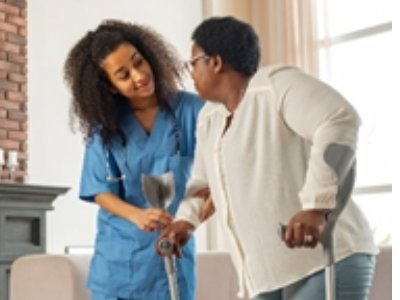Balance and Fall Prevention Program
Ultimate Home Health Care’s Balance and Fall Prevention Program brings together our team of skilled in-home therapists, nurses, and attendants from different disciplines and uses the latest research and processes in order to educate patients on best practices to prevent injury. The program is a comprehensive approach that helps individuals reduce the risk of falls and other physical injuries at home while avoiding unnecessary trips to the hospital.
Program Features
Supervised and supported by physicians and therapists
Personalized prevention plan
Processes informed by the latest research
Multi-discipline in-home care team
Education for family, caregivers, and patients
Balance and Fall Prevention Program Guide:
Comprehensive guide focused on prevention and risk reduction, including fall factors, prevention tips, fall and balance education, exercise programs to improve fall prevention, best practices, a home fall prevention checklist, and treatment goals tools
Symptom management tool to quickly and accurately identify changes in condition and increased risk of falls
Program Goals
Manage and improve balance, reduce fall risk
Reduce required visits to the hospital
Improve independence
Improve movement and activity
Educate on when to call for help
Balance and Fall Prevention – What you need to know
The Numbers:
Unintentional injuries are the 7th leading cause of deaths among adults ages 65 and older in the United States. Of these deaths, the greatest number results from unintentional fall-related injuries. Older adults who fall once are 2-3 times as likely to fall again within a year and approximately 25%-35% of community-dwelling people over the ages of 65 fall 1-2 times each year. 60% of all fall-related deaths that occurred in 1996 involved adults 75 years and older.
Age Is a Factor:
Advanced age substantially increases the likelihood of hospital admission following a fall-related injury. Approximately half of people living in nursing homes fall each year, and 11% sustain a serious fall-related injury. In people over the age of 65 who are living independently, the incidence of falls is approximately 30% – more than half of which happen at home. The incidence rises to 50% in those over the age of 80.
The Basics of Balance:
Balance is the ability to maintain the body’s center of mass over its base of support. Good balance exists because multiple systems interact flawlessly and automatically, providing accurate and exact information to our nervous systems. We constantly process, assess, and re-assess information about the strength, force, timing, and speed of movement. The brain receives signals from sensory receptors located in the eyes, inner ears, joints, muscles, and skin – all providing important information for balance.
Factors That Impact Balance:
In people under age 75, falls are most often associated with normal aging, such as loss of strength, visual changes, loss of flexibility, and decreased reflexes. Over the age of 85, the effects of multiple medical conditions and the medications used to treat them become more of a factor. Other factors include:
Sensation of the feet
Visual changes
Inner ear issues
Cognitive impairment
Loss of strength
Loss of flexibility
Decreased reflexes
For further information and to see if you qualify, please call 972-240-4700.



